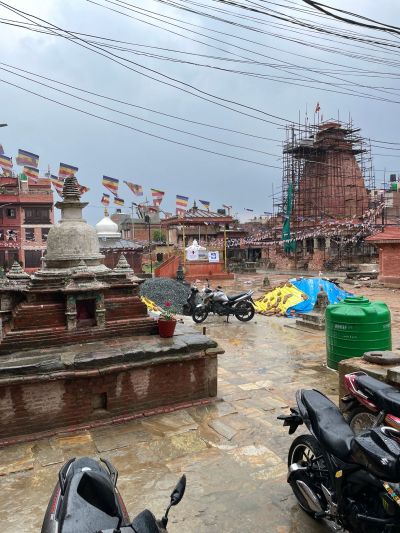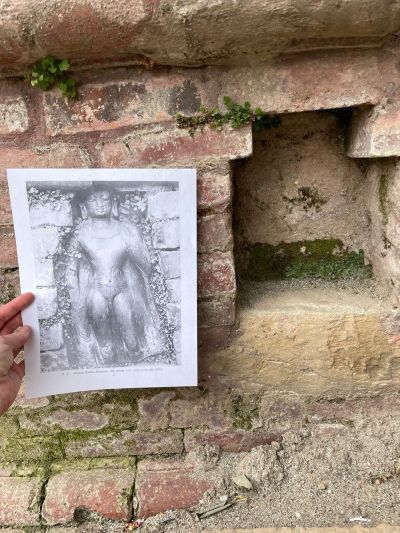
Photo courtesy of Erin Thompson.
The University of Michigan Museum of Art (UMMA) is seeking to deaccession a 9th-century stone Buddha to allow for its repatriation it to Nepal.
UMMA said it had “determined that deaccessioning and repatriating the statue is appropriate in this instance because the statue’s provenance has been credibly challenged,” according to a document submitted to the University of Michigan’s board of regents for its meeting on September 19 to approve the deaccession.
“The statue was received as a donation in 2016, and the donor provided a 1988 purchase receipt from a London antiques shop; there are no reliable records prior to that date. Moreover, ample and persuasive information has been provided to UMMA showing the statue was likely taken from Nepal without authorization in the mid-1970s.”
Art crime professor Erin L. Thompson, who has also been an advisor to the Nepal Heritage Recovery Campaign, visited the site in May where the statue used to be located and spoke to community members about their memories of when it was stolen. Prior to the statue’s theft, it had been part of a chaitya (a public place of prayer or worship) in the Nepali village of Bungamati, 45 minutes from the country’s capital of Kathmandu.

Photo courtesy of Erin Thompson.
“I think the the university wanted to know, was this a voluntary sale or not,” Thompson, who is a professor of art law at the John Jay College for Criminal Justice, told ARTnews. “It wasn’t that the community got tired of this and sold it off like an old tchotchke. They wanted to keep it then, and they want it back now.”
“It was also useful, I think, for me, to go to the site and take photographs of the niche, the empty niche, because you can see that the bricks line up,” she said. “It’s the same type of of lichen growing on it, like everything checks out.”
Thompson has been following this case for over a year after the 9th century Buddha statue was flagged by Lost Arts of Nepal, a Facebook page dedicated to raising awareness of stolen artifacts.
Last May, Lost Arts of Nepal compared photographs of the statue in its chaitya with three taken by art scholars, historians, and a local heritage activist Anil Tuladhar. The first image was by art historian Lain Singh Bangdel and published in his 1989 book, Stolen Images of Nepal. In 2019, art scholar Ulrich Von Schroeder published another image of the Figure of Buddha in the second volume of “Nepalese Stone Sculptures”.
The Facebook post by Lost Arts of Nepal said the statue was sold at a Christie’s auction in New York in September 2015 and then was in a private collection in Michigan. The current Christie’s website for that month’s sale of Indian, Himalayan and Southeast Asian Art does not show a listing for the piece. Lost Arts of Nepal claimed that the work was Lot 78, which is missing from the website.
The document submitted to the University of Michigan’s Board of Regents also cites the history of stolen and looted artifacts from “this region of the world” as why repatriation of the Figure of Buddha would be “appropriate and consistent with museum best practices for collection management.”

A comparison of the historical image of the statue and the empty niche. Photo courtesy of Erin Thompson.
A listing for Figure of Buddha (since taken down) identified the 18-inch-tall statue as made of black stone and that it was donated to the institution in 2016 by Mary Paul and Bruce Stubbs. According to an obituary published in the Ann Arbor News, Stubbs attended the university’s medical school and trained as an orthopedic surgeon. He and his wife Mary Paul often went on missionary trips to developing countries.
If the board of regent do approve the deaccessioning of Figure of Buddha, Thompson said there is no precedence or set procedure for what happens next. While some museums have covered the costs for repatriation in past cases, others have dropped off items at the closest Nepali embassy, or told the embassy to come pick up the item.
“I think it seems right for the possessor to bear some of the costs of return,” Thompson sais. “But who knows what will happen. Sometimes the Nepali government has had private Nepali American groups pay for the transit of one of two returns lately from New York or FedEx has donated the flight transport.”
“It’s not a rich country,” she said.
Thompson noted that one of the other three Buddhas from the same chaitya was previously in the possession of Hollywood producer and art collector Michael Phillips. After Lost Arts of Nepal identified it in Phillips’s collection last January, Thompson negotiated with him and he repatriated it to Nepal several months later.
When Thompson visited the village of Bungamati this past May, residents were already planning for the reinstallation of the other Buddha that had been returned. “They are very much looking forward to having a ceremony of reinstallation,” she said. “They want it back.”
When ARTnews asked the University of Michigan for official comment on September 18, spokesperson Dana Elger wrote in an email, “At this time, we have nothing further to add beyond what’s noted in the action item you’ve referenced.”
The Embassy for Nepal in Washington, DC did not respond to requests for comment from ARTnews.
The Board of Regents at the University of Michigan voted unanimously to approve the deaccession during its meeting on September 19 shortly before 5pm.
Update, September 19, 2024: Added the results of the board’s vote.
 Print
Print